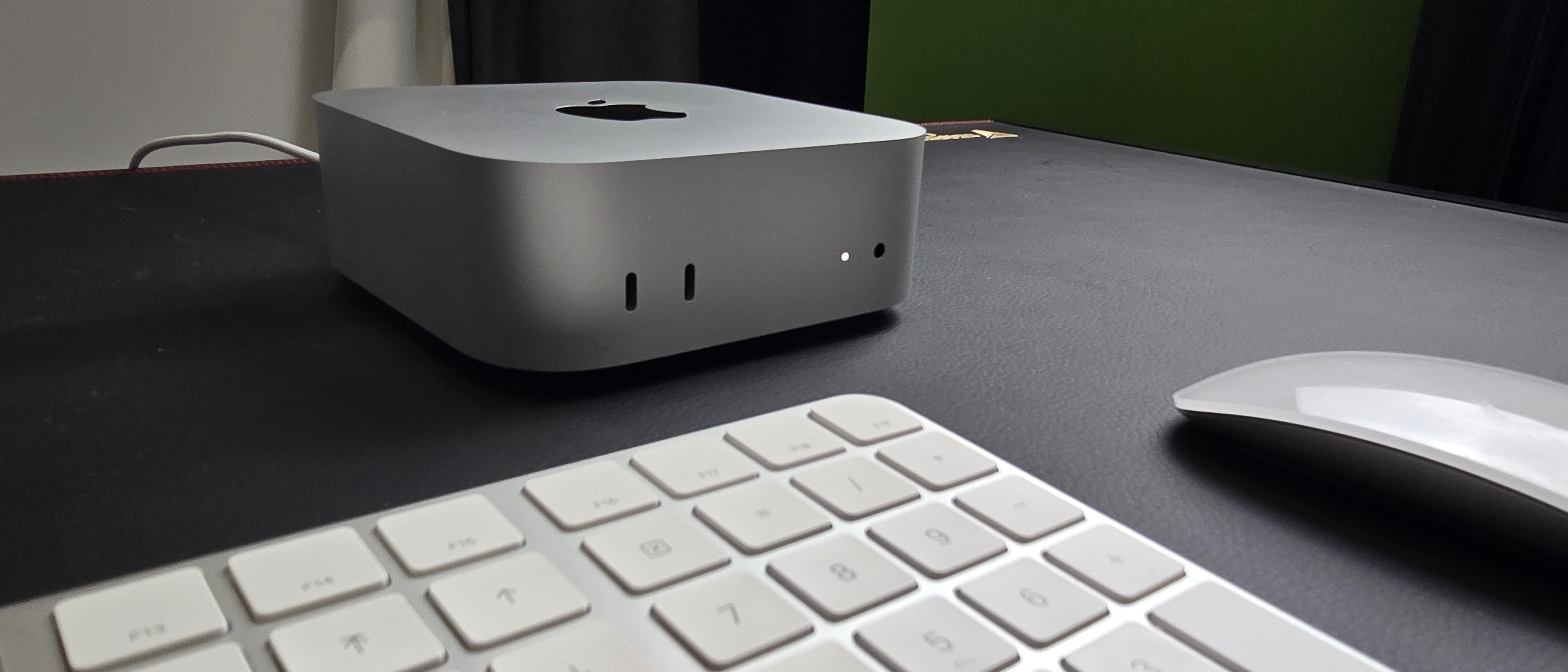TechRadar Verdict
Before Apple announced its new M4-series Macs and MacBooks I made a prediction that the Mac mini would be the most interesting out of all of them - and I was right. Apple has made what was already the best small form factor PC even better thanks to a more compact design, and it packs the new M4 and M4 Pro chips - all while offering incredible value for money as well. I can't recommend this Mac enough.
Pros
- +
Great performance
- +
More compact design
- +
Awesome value
Cons
- -
Struggles with modern games
- -
Front USB-C ports are slower than rear
- -
Power button placement is awkward
Why you can trust TechRadar
Two-minute review
The new Mac mini (M4, 2024) doesn’t just prove that good things come in small packages – it also confirms the old adage that good things come to those who wait.
That’s because ever since Apple’s rather strange decision to debut the M4 chip in the iPad Pro in early 2024, myself – and I’m sure other Mac fans – have been not-so-patiently waiting for Apple devices that can take full advantage of the M4 chip (as good as the iPad Pro is, you can only run iPadOS apps on it – which by their very nature are not that demanding).
The fact that Apple has launched a new Mac mini that not only comes with the new M4 chip (or the more powerful M4 Pro), but has redesigned it to be smaller than ever – while also keeping the price of entry the same – is incredibly exciting. In my review of the Mac mini (2023), I gave a rare five stars and called it the best mini PC you can buy, and even before the launch I was banging on about how any rumored new Mac mini for 2024 would be more exciting than new MacBooks.
Now that I’ve actually got the Mac mini (M4, 2024) in my hands (and on my desk), I’m pleased to say that I’ve not been disappointed, and once again the Mac mini is the most affordable way to get into the Mac ecosystem, while also proving that if you’re looking for a small form factor desktop PC, there’s not a single Windows 11 PC out there that can even come close.
Perhaps the best news (apart from the mere fact that the M4 Mac mini exists) is that Apple has kept the price of the base model at just $599 / £599 / AU$999, a welcome decision that—combined with the new design and improved specs—means the Mac mini is now better value than ever. If you’ve been keen to join the macOS ecosystem but can’t afford a MacBook or iMac, then the Mac mini remains an excellent choice.
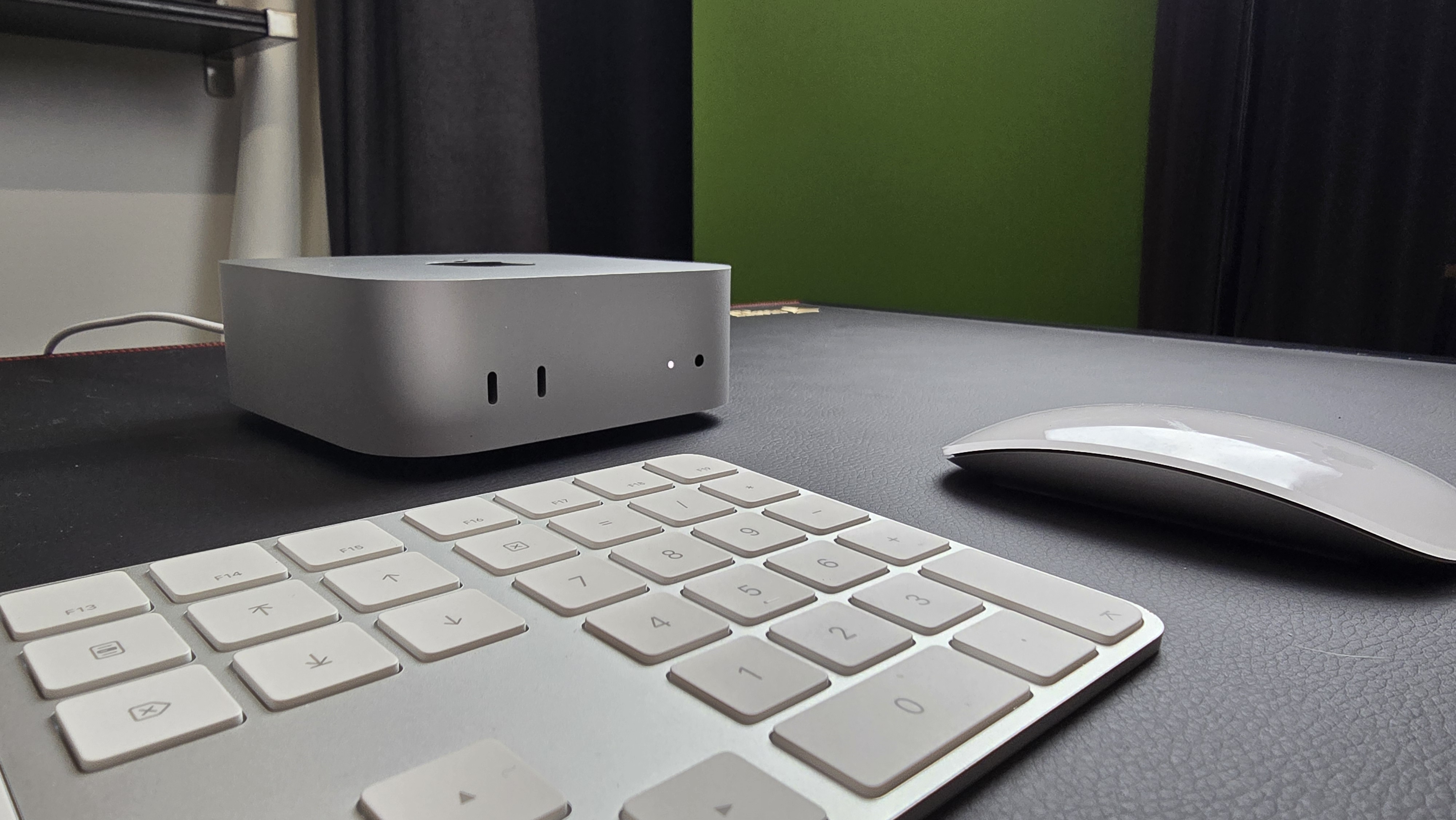
For people after even more power, there’s an M4 Pro model as well that costs $1,399 / £1,399 / AU$2,199. Both models come with 16GB unified memory as standard (double the amount as the previous model), and will receive Apple Intelligence AI features as they are rolled out.
Not only do you get the latest slice of Apple Silicon with the new Mac mini, but it has also had a major redesign – its biggest in over a decade – making it more compact than ever. It’s seriously impressive how small the new Mac mini is, and it makes placing it in any room of your home (or office) easier than ever. Thanks to two USB-C ports at the front, the Mac mini (M4, 2024) is an ideal mini PC for your front room – especially as gaming is a renewed focus for Apple. This could be the closest we ever come to an Apple games console – and with a price tag below the PS5 Pro, this could be the start of a resurgence for Mac gaming.
From my time with the Mac mini I was incredibly impressed with the performance of this tiny PC. The latest version of macOS, Sequoia, ran smoothly, and even advanced tasks such as video editing were handled with ease – and the Mac mini kept virtually silent throughout. The model I reviewed is the M4 version, and to be honest it performed so well for all the tasks I used it for that I would recommend this model over the far more expensive M4 Pro iteration.
So, Apple has done it again: it’s released the best small form factor PC in the world, and I can’t see Windows 11 or Linux alternatives coming close to the build quality, performance and value for money of the new Mac mini for a long, long time. If ever.
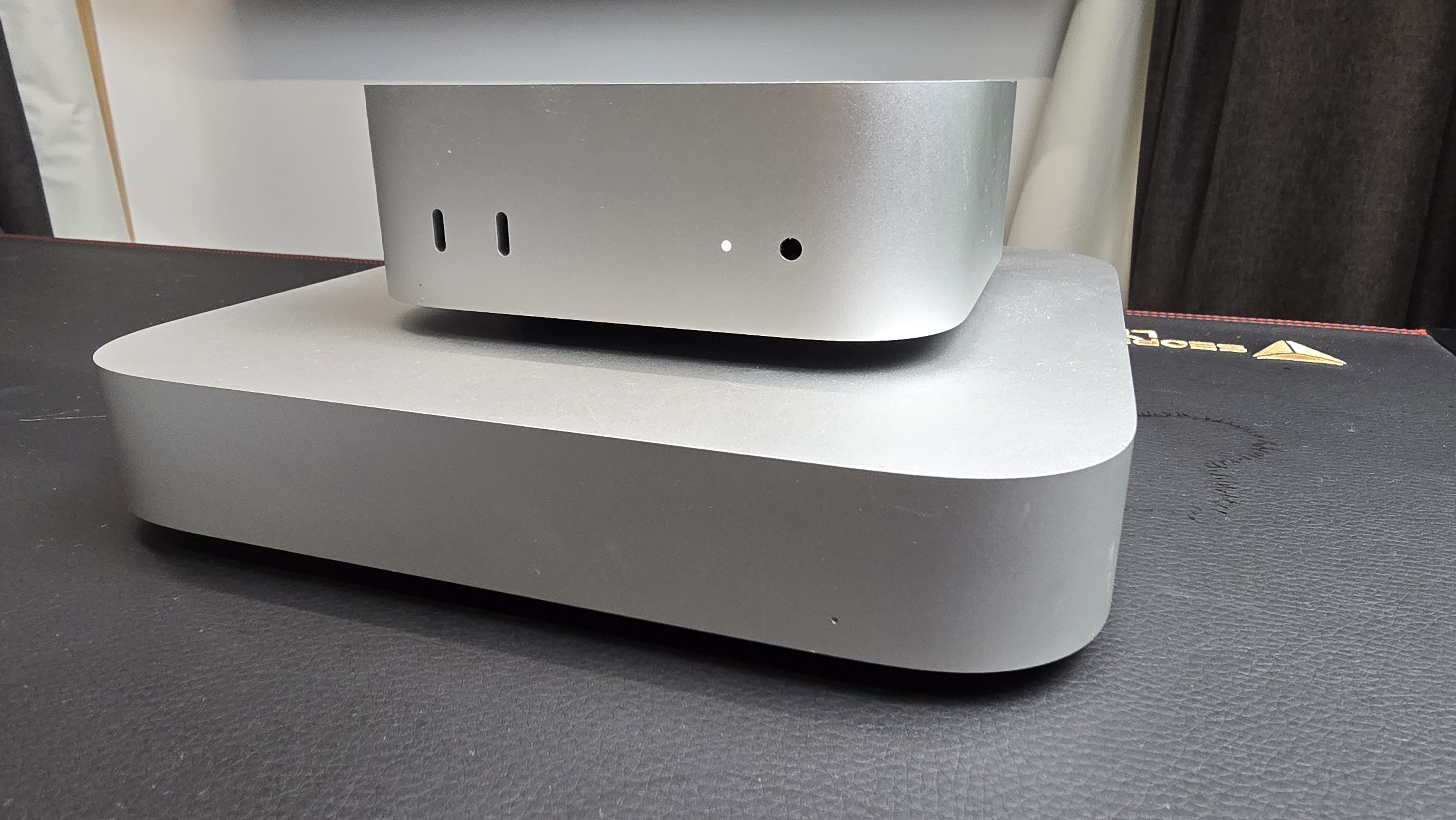
Mac mini (M4, 2024) (M4 Pro, 2024) review: Price and availability
- Starts at $599 / £599 / AU$999
- Same price as M2 model
- M4 Pro model much more expensive at $1,399 / £1,399 / AU$2,199
When the Mac mini (M4, 2024) was announced and pre-orders went live on October 29, 2024, one of the most pleasant surprises was that the base M4 model comes with the same price tag as the M2 model - starting at $599 / £599 / AU$999.
The M2 Mac mini already represented excellent value for money – it would be extremely difficult to find a compact Windows 11 PC at that price range that offered the same level of performance – so the fact that you’re getting an upgrade in both performance and design for no extra cost is something to applaud – though if you recently bought an M2 Mac mini, you might feel a bit aggrieved.
The M4 chip inside the Mac mini is the same as the one in much more expensive devices, including the iPad Pro (starting at $1,299 / £1,299 / AU $2,199), iMac ($1,299 / £1,299 / AU$1,999) and 14-inch MacBook Pro ($1,599 / £1,599 / AU$2,499). Sure, with the Mac mini you don’t get a screen, nor do you have the ability to work on it while traveling, but offering the same amount of power for around half the price still represents incredible value for money.
The M4 chip features up to a 10-core CPU (4 performance cores and 6 efficiency cores) and a 10-core GPU, up from the 8-core CPU and 8-core GPU of the base M3 chip (Apple never released a Mac mini with the M3, it should be noted), and supports up to 38 trillion operations per second (TOPS) in its 16-core neural engine (Apple's version of an NPU) - so when Apple Intelligence, the company’s generative AI (artificial intelligence) feature does come to macOS, the M4 Mac mini will be more than prepared.
It’s not just the M4 chip that brings a performance upgrade, as the base model now comes with 16GB of unified memory, twice that of the M2 Mac mini’s base model. Not only does this mean the new Mac mini is much better at multitasking (as there’s more memory to support multiple apps running at once), but it’s also more future-proof.
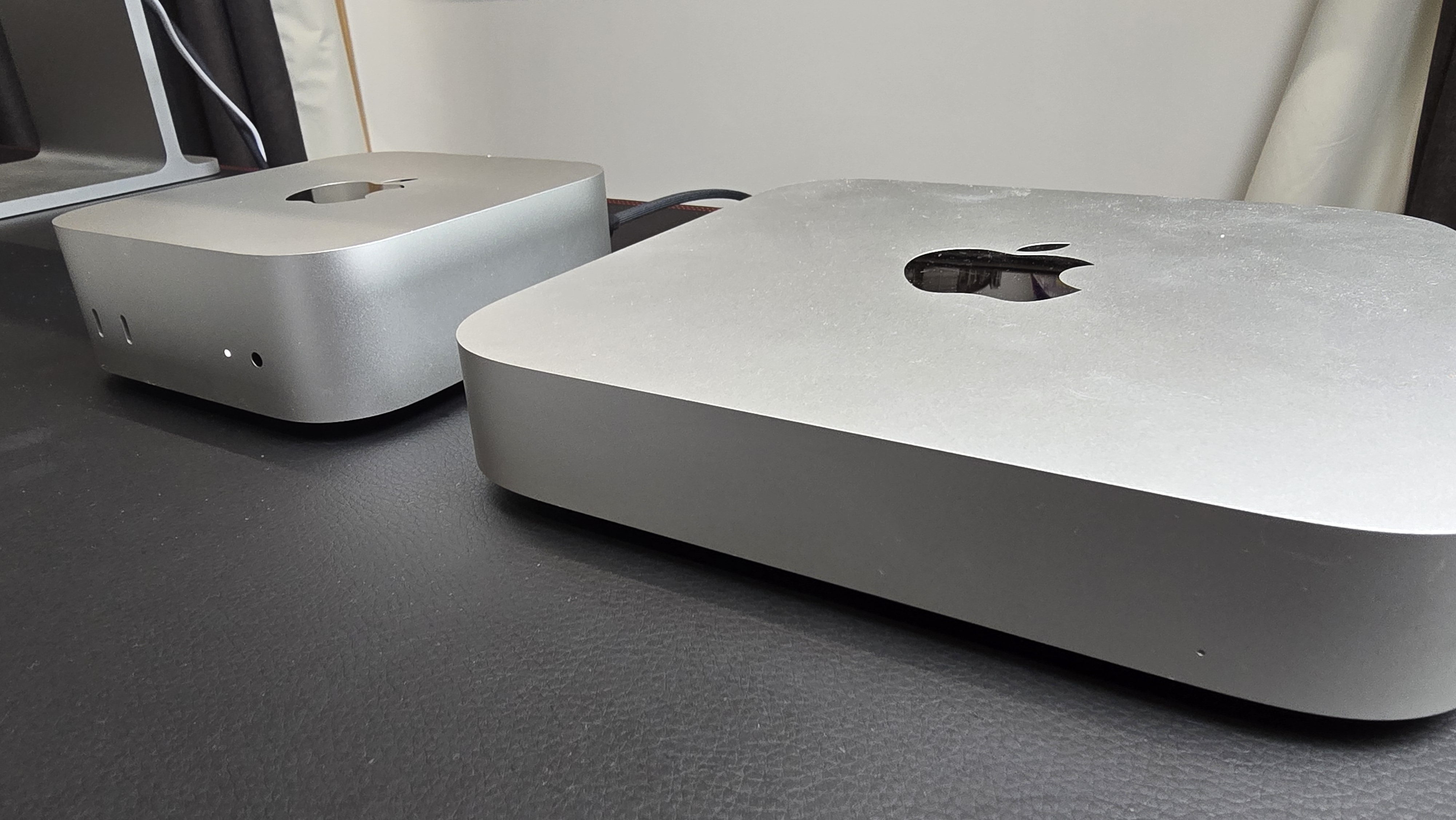
You can also get the new Mac mini with the more powerful M4 Pro chip, which starts at $1,399 / £1,399 / AU$2,199. That’s quite a price jump, and while the M4 Pro is certainly a promising bit of silicon on paper, it’ll have to really outperform the M4 to justify the price difference.
We’ve been sent the M4 version to review, and for the majority of people, that should be more than capable enough for the kind of tasks they’ll need this tiny PC to perform. Having the M4 Pro option is nice, despite the price hike, as you are getting a seriously powerful PC in a tiny and almost silent form factor.
There was also a brief moment between Apple announcing the new Mac mini and it revealing the new MacBook Pros with M4 Pro where the M4 Pro Mac mini was arguably the most powerful Mac device ever. Remarkable.
- Value score: 5/5
Mac mini (M4, 2024): Specs
| Header Cell - Column 0 | Mac mini M4 16GB, 256GB SSD | Mac mini M4 16GB, 512GB SSD | Mac mini M4 24GB, 512GB SSD | Mac mini M4 Pro 24GB, 512GB SSD |
|---|---|---|---|---|
| Price: | $599 / £599 / AU$999 | $799 / £799 / AU$1,299 | $999 / £999 / AU$1,599 | $1,399 / $1,399 / AU$2,199 |
| CPU: | Apple M4 (10-core) | Apple M4 (10-core) | Apple M4 (10-core) | Apple M4 Pro (12-core) |
| Graphics: | Integrated 10-core GPU | Integrated 10-core GPU | Integrated 10-core GPU | Integrated 16-core GPU |
| RAM: | 16GB unified memory | 16GB unified memory | 24GB unified memory | 24GB unified memory |
| Storage: | 256GB SSD | 512GB SSD | 512GB SSD | 512GB SSD |
| Ports: | 2x USB-C, 3x Thunderbolt 4 (USB-C), HDMI, 3.5mm headphone jack, Ethernet | 2x USB-C, 3x Thunderbolt 4 (USB-C), HDMI, 3.5mm headphone jack, Ethernet | 2x USB-C, 3x Thunderbolt 4 (USB-C), HDMI, 3.5mm headphone jack, Ethernet | 2x USB-C, 3x Thunderbolt 5 (USB-C), HDMI, 3.5mm headphone jack, Ethernet |
| Wireless: | Wi-Fi 6e (802.11ax), Bluetooth 5.3 | Wi-Fi 6e (802.11ax), Bluetooth 5.3 | Wi-Fi 6e (802.11ax), Bluetooth 5.3 | Wi-Fi 6e (802.11ax), Bluetooth 5.3 |
| Weight: | 1.5 lbs (0.67kg) | 1.5 lbs (0.67kg) | 1.5 lbs (0.67kg) | 1.6 lbs (1.6kg) |
| Dimensions: | 2 x 5 x 5 inches (50 x 127 x 127mm) | 2 x 5 x 5 inches (50 x 127 x 127mm) | 2 x 5 x 5 inches (50 x 127 x 127mm) | 2 x 5 x 5 inches (50 x 127 x 127mm) |
Mac mini (M4, 2024): Design
- Brilliant, smaller design
- Front USB-C ports are welcome
- Power button placement is a bit awkward
The Mac mini (M4, 2024) has received its biggest redesign since arguably 2011, and it’s now what Apple calls its “smallest computer ever”.
Where the previous model had dimensions of 197 x 197 x 35.8 mm (7.75 x 7.75 x 1.41 inches), the new Mac mini (M4, 2024) measures just 127 x 127 mm x 50 mm (5 x 5 x 2 inches). When taking it out of the box, it’s seriously impressive how small it is, easily fitting in the palm of your hand. Placing it on top of the M2 model, the older Mac mini looked big and bulky – something I’d never have imagined, as that was an impressively small bit of kit when it launched.
The new Mac mini is a bit taller than the older models, but if that’s the sacrifice that had to be made in order to shrink the overall footprint of the PC, while packing it with the latest tech, then it’s one I’m happy with. It’ll easily fit behind a monitor, and even in front of a screen, it’s unobtrusive enough that you’ll hardly notice it. Its small size also means you can plug it into your TV and it won’t look out of place in your lounge. For anyone holding out for an Apple games console, the Mac mini (M4, 2024) could end up being as close as you’re going to get.
As if to prove that the new Mac mini can be just as at home in a lounge as in an office or studio, it now comes with two USB-C ports at the front, alongside a headphone jack for easy access.
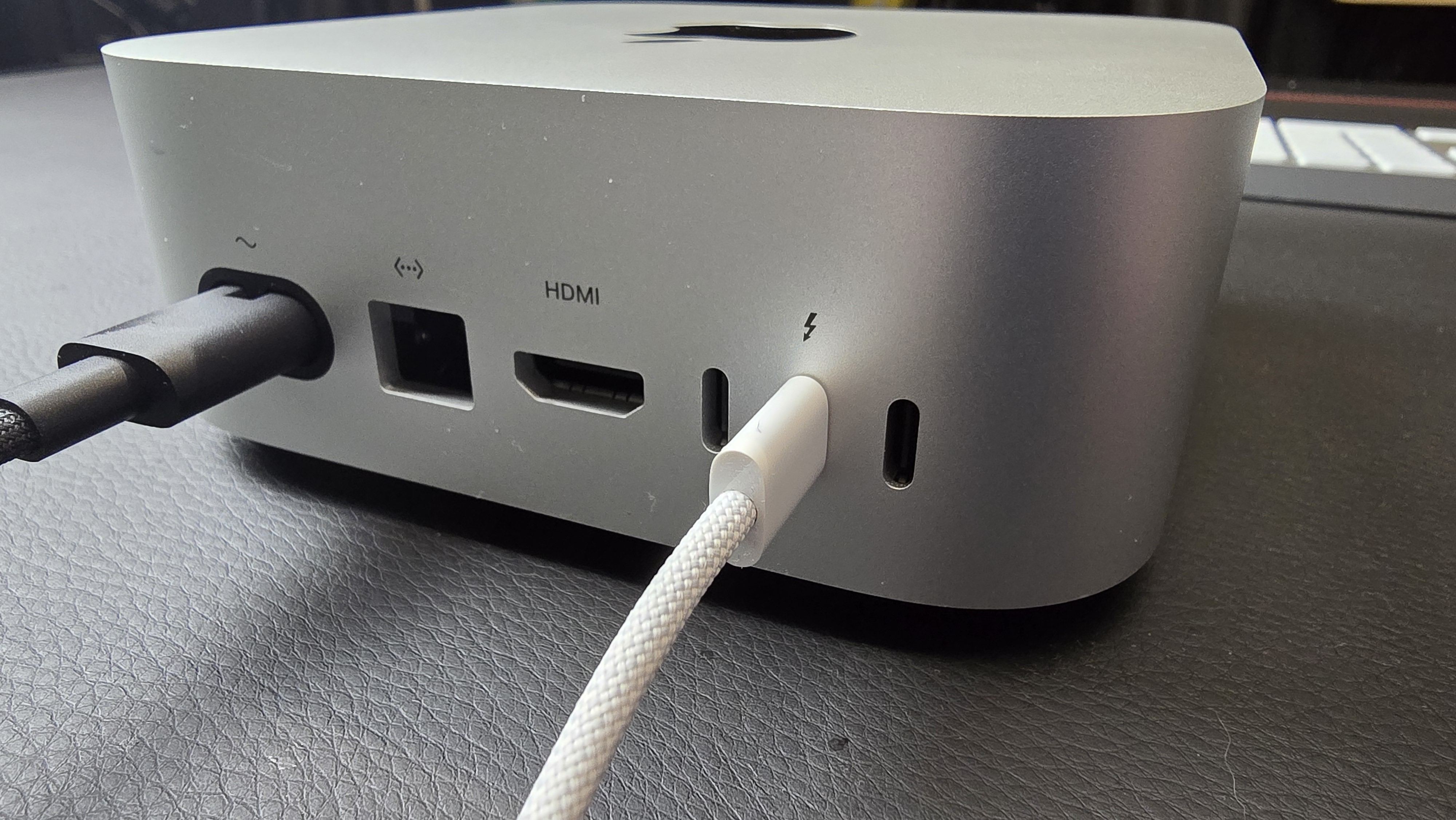
At the rear there’s a power port (impressively, despite the tiny size, there’s no bulky external PSU), an Ethernet port and an HDMI that’s capable of up to 8K at 60Hz, or 4K at 240Hz.
There are also three additional USB-C ports. While the front USB-C ports are limited to USB 3 speeds (10Gb/s), the three on the back are much faster. With the M4 model, the rear ports are Thunderbolt 4, with speeds of up to 40Gb/s. If you go for the M4 Pro model, those are upgraded to Thunderbolt 5, with speeds of up to 120Gb/s.
While it’s a shame that the front USB-C ports are slower than the rear ones, if you’re mainly using them for plugging in and charging peripherals, they’ll be fine, leaving the rear ports for tasks that need faster data transfer speeds – such as external hard drives or additional screens.
While the new design is a triumph on the whole, one element of the redesign has caused controversy – the placement of the power button. Rather than being on the rear right-hand corner of the Mac mini, as with previous models, it is now located on the bottom of the Mac mini by the rear left-hand corner. While the Mac mini is raised from the surface you place it on by a circular air vent bottom-center of the PC, you still need to lift it up to reach the button. As the new Mac mini is so small and light, and there are no moving parts inside (except for fans), this isn’t too much of a problem, though if you’ve placed the Mac mini in a TV cabinet or somewhere where it’s hard to reach, it could be frustrating.
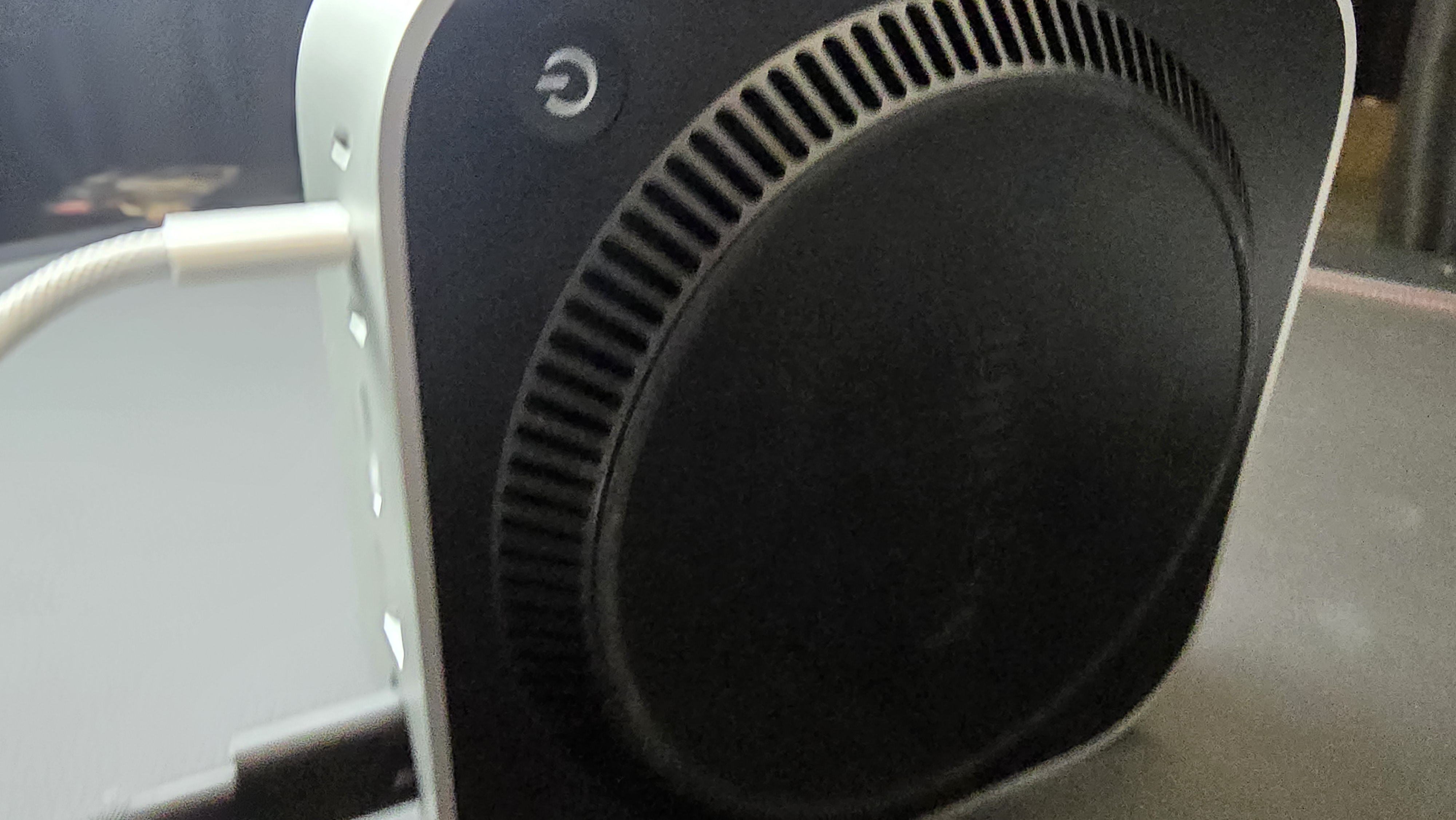
There are workarounds – you could just put the Mac mini to sleep rather than shutting it down, and waking it up by moving the mouse or tapping the keyboard, but even Macs need to be fully powered down every now and again. You could also use the Wake-on-LAN feature of macOS, which allows you to turn on the Mac mini by sending a command over the internet, though again you’ll need the Mac mini to be asleep, not fully turned off.
It’s certainly not the end of the world, but it’s not one of Apple’s better design choices. Placing the power button on the top or front of the Mac mini might ruin the aesthetics, but would have been easier to reach – or even having the power button still on the bottom, but on one of the front corners would have helped.
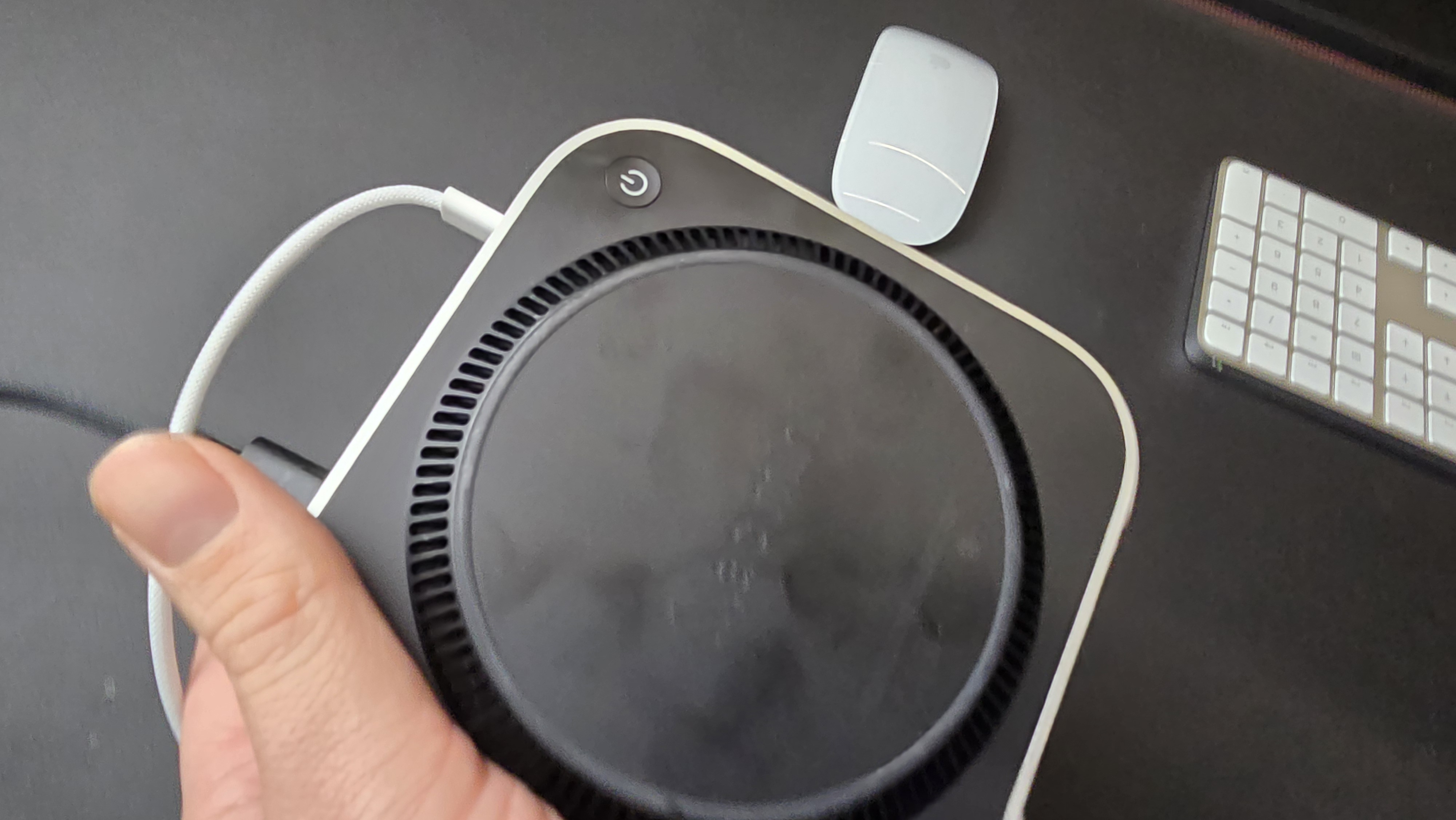
The new Mac mini only comes with the device itself and a power cord. Any other cables or peripherals will need to be bought separately (though if you’ve already got, say, an HDMI cable and a mouse and keyboard, then that shouldn’t be too much of a burden).
If you need peripherals to go with the Mac mini you can buy the Magic Keyboard for $99 / £99 / AU$149, the Magic Trackpad for $129 / £129 / AU$209, and the Magic Mouse for $79 / £79 / AU$149. These have had slight design changes as they now use the universal USB-C cable to plug in and charge, rather than Apple’s proprietary Lightning cable, which is good to see.
Sadly, Apple didn’t take the opportunity to move the charging port of the Magic Mouse – it’s still located at the bottom of the mouse, which is a baffling design choice as it means when you plug it in to charge you can’t continue using it.
Of course, you don’t need these new peripherals as any Mac-compatible mouse or keyboard (which is any mouse or keyboard, basically) will work – though there’s no full-size USB A port anymore, so if those peripherals aren’t USB-C or Bluetooth, then you might need to buy an adapter.
- Design score: 4.5/5
Mac mini (M4, 2024) review: Performance
- Excellent performance
- Virtually silent
- Can even play some games
Once upon a time I was rather worried that Apple had fallen out of love with Macs, and especially the Mac mini, as the company seemed far more enamored with its iPhone and iPads, leaving its Macs to make do with incremental hardware updates within increasingly outdated designs.
Then Apple dumped Intel and made its own chips, starting with the M1 in 2020, and my doubts have pretty much vanished, as every major Mac device has not only been upgraded to an M-series chip, but they’ve also had noticeable redesigns as well, proving that Apple is committed to its Mac lineup. So, it’s with some relief that the Mac mini has not just got the latest M4 (and M4 Pro) chips, but also a major redesign as well, as it’s likely to be one of Apple’s more niche products.
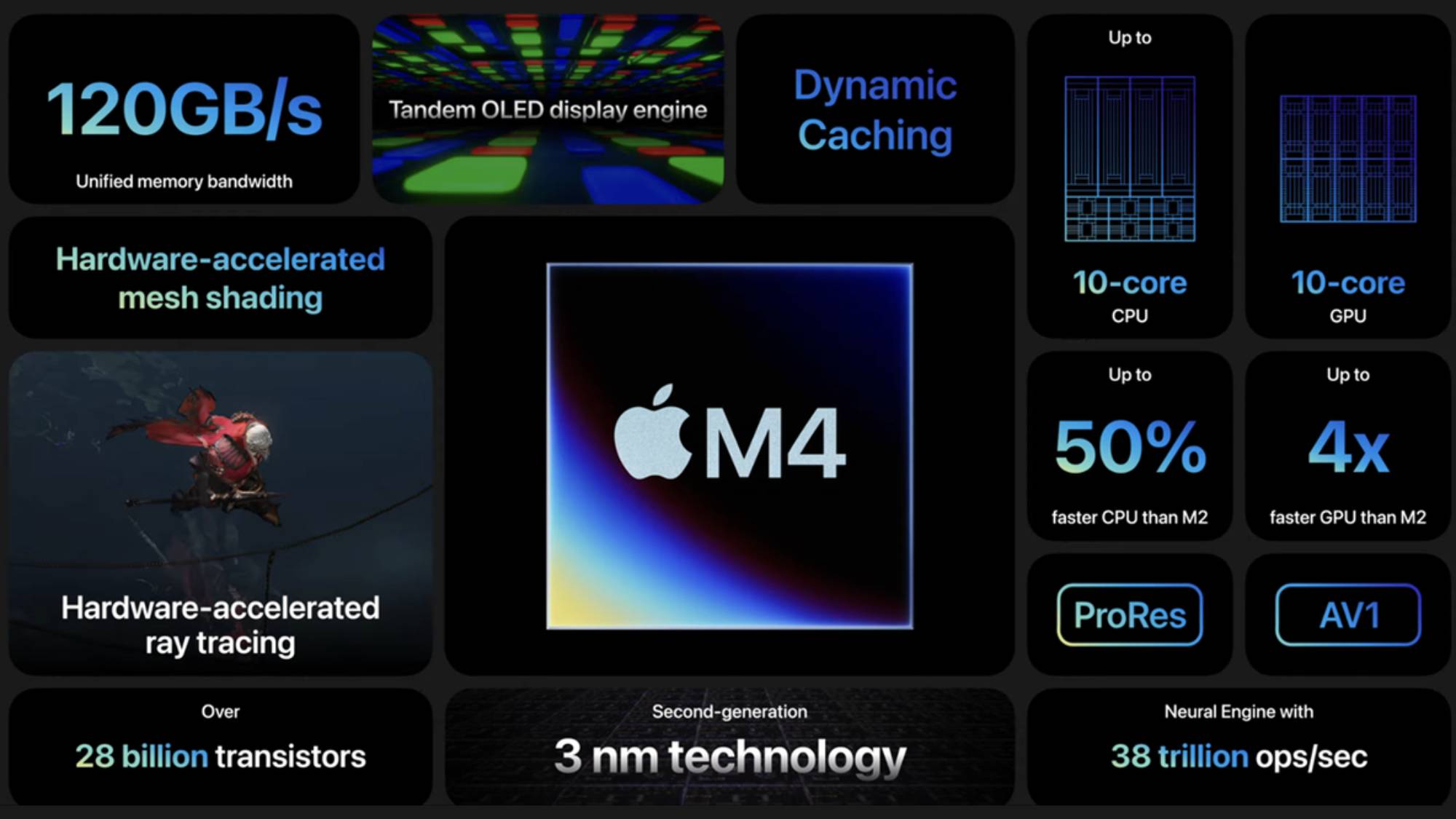
It shouldn’t be – since getting M-Series chips, the Mac mini has become the best small form factor PC you can buy. Small PCs with either Windows 11 or Linux simply cannot match the build quality, performance, and price of Apple’s tiny machine, and with the M4 chip, that gap has become even wider.
Along with the 10-core CPU and 10-core GPU of the M4, the chip contains 28 billion transistors, up from 25 billion in the M3, but is still built on the same 3nm process node from TSMC, so a generational leap is out of the question.
In synthetic benchmarks there’s around a 20% increase in CPU performance when using Geekbench 6, though GPU performance upticks are more modest, with between 5% - 14% increases in benchmarks.
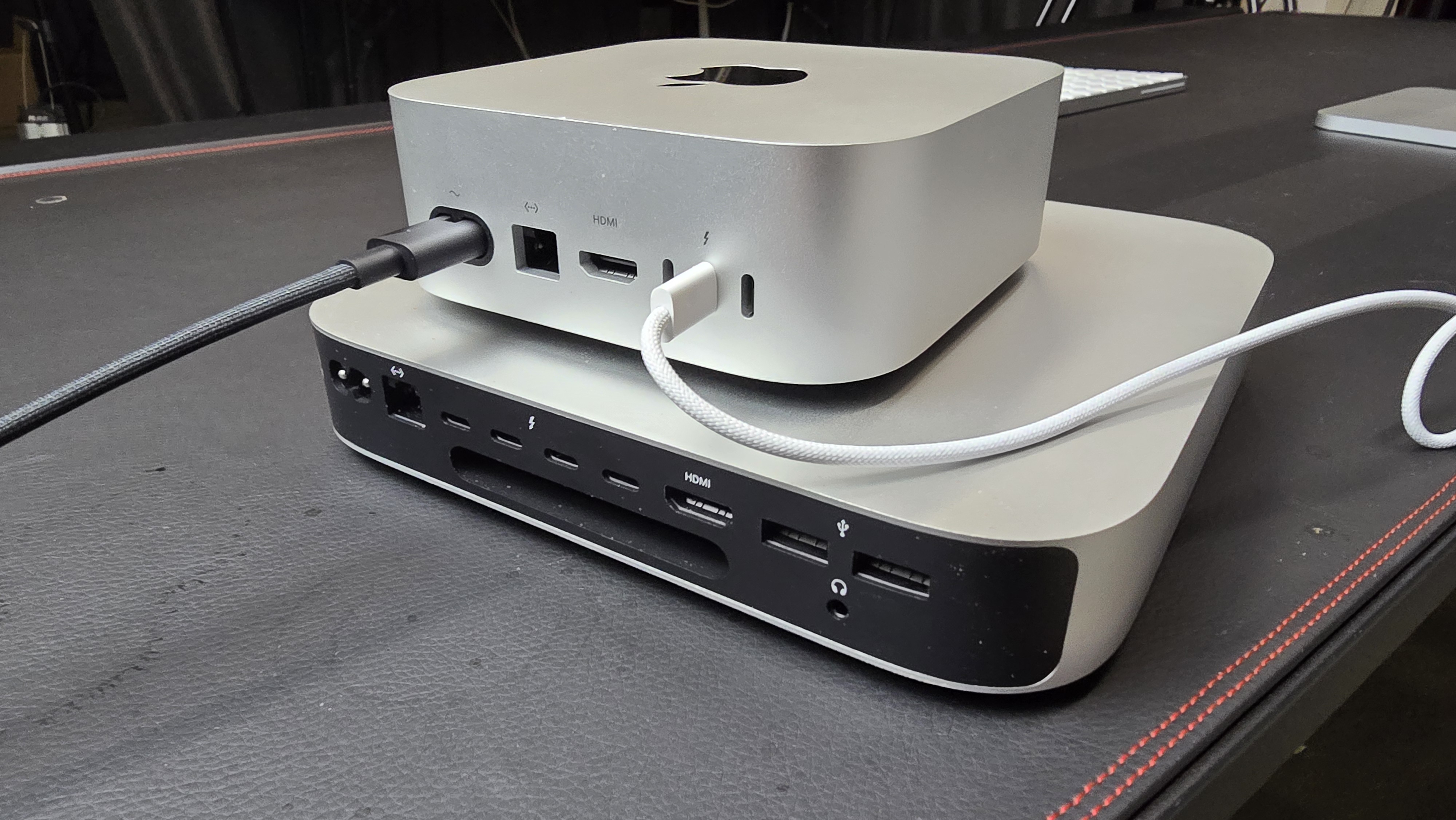
While any increase is always welcome, those kind of numbers mean if you have an M3 Mac mini, you won’t really see any major differences in performance, so upgrading might not be worth it (unless you absolutely have to have the smaller design of the newer Mac mini, which I wouldn’t blame you for).
Where things do get interesting when comparing performance between the M3 and M4 Mac mini is when it comes to AI – both artificial intelligence and Apple Intelligence. With the M4, Apple has included another 16-core Neural Engine dedicated to machine learning and AI tasks, and in AI benchmarks the results are pretty remarkable, with around a 35% increase in performance over the M3. Whether or not Apple Intelligence, or AI in general, will usher in the computing revolution we’ve been promised by many manufacturers has yet to be seen, but at the very least you know that if you buy an M4 Mac mini (or any M4 device), you’ll be in good stead should you wish to use future AI tools.
According to Apple, the M4 chip is capable of 38 TOPS - that's 38,000,000,000,000 operations per second – which is incredibly impressive and means on-device AI tasks should run well. However, the Snapdragon X Elite, like the M4 an ARM-based chip built for Windows 11 devices, offers 45 TOPS. That difference in operations per second isn’t huge, and it might not even be noticeable, especially when comparing Windows 11’s Copilot AI tool to Apple Intelligence, but it’s worth noting.
Apple Intelligence is introduced to Macs in macOS Sequoia 15.1 – and you’ll need to update the new Mac mini to get that version – thankfully, it’s quick and easy process.
The model I review here is the Mac mini with M4 chip, 16GB of unified memory, and a 512GB SSD. For day-to-day tasks, where I used the Mac mini for writing this review, browsing the web and general admin, it worked brilliantly. The operating system – macOS Sequoia – booted quickly, and every app I used loaded speedily and ran smoothly.
We’re now four years on from when Apple made the major move from Intel-based hardware to ARM-based, and that has allowed pretty much every major Mac application to make the move as well. This means it’s now very rare to have to use Apple’s Rosetta 2 tool, which allows apps made for Intel Macs to run on modern Apple Silicon Macs. That tool was essential in the early M1 days, and it meant you could still run your apps with minimal impact to performance.
Now that almost every Mac app, including those from third parties, runs natively on Apple Silicon means they can fully take advantage of the power of the M4 chip (though Steam, the popular store and launcher for PC games, still requires Rosetta to run).
Here’s how the Mac mini (M4, 2024) performed in our suite of benchmark tests:
Cinebench 2024 CPU: Single-Core: 161; Multi-Core: 833
Geekbench 6.3 Single-Core: 3,838; Multi-Core: 14,838
Blender: Monster: 391; Junkshop: 187.6; Classroom: 185.2
One of the best things about Apple’s M-class chips is that the company has made a big commitment to making them as power-efficient as possible, and while this might benefit MacBooks more, as it means they can enjoy longer battery lives, the Mac mini also benefits, as the more efficient M4 chip runs cooler, which allowed Apple to shrink the body of the Mac mini – and it also means the built-in fans that are used to expel hot air when the components are being used rarely kick in. For almost all of my time using the new Mac mini, it was virtually silent. This is great when using it in an office or studio, and it also makes it an ideal mini PC for the front room.
Even when switching to more intensive tasks, such as editing videos in Adobe Premiere Pro, the Mac mini kept pace brilliantly as I added 4K footage and scrolled between scenes. When it comes to gaming, the Mac mini (M4, 2024) was surprisingly good – on high graphical settings, it ran Shadow of the Tomb Raider at 44fps, well above the 30fps I consider to be minimum for a game to be playable, and with a bit of tweaking I think you’d get to 60fps.
Running Total War: Warhammer 3 at Ultra scored just 22.1fps, however. This game is more strenuous on the CPU rather than the GPU, though when I set the visual settings to low it hit 55.4fps. These are modern and ambitious games, so for a compact PC that’s not designed for gaming at this price, that performance is pretty darn great, and you have access to a huge library of Mac games through Steam and other platforms. Throughout playing, the Mac mini remained completely silent.
While the M4 model isn’t going to trouble the PS5 Pro any time soon when it comes to playing games, the fact that such a small device can still give a decent experience is pretty cool, and I assume the M4 Pro model is an even more competent gaming device, though for the price that is a lot steeper than any console - and even many gaming laptops.
Apple has also made a big deal about the M4 chip and its AI abilities, and from my tests it's... fine. Apple Intelligence is in its infancy, so I could not try out all the features that are coming, but I was able to edit a photo in the included Photos app and use the AI-powered Clean Up feature to remove elements from a photo. It worked as well as you might expect these early AI features to perform - it was quick and easy to do, but the background the AI generates in order for the objects you select (by painting over them with a brush) left mistakes and errors that mean it's far from perfect, and you can easily tell AI has been used.
From the AI tools so far, they are interesting yet not essential - bascially the same problem many AI tools have at the moment. For the Mac mini's part, it performed those AI feats all on-device, and they were done quickly and speedily. This is an area where I can see the Mac mini improving.
- Performance score: 4.5/5
Mac mini (M4, 2024): Should you buy it?
| Attributes | Notes | Rating |
|---|---|---|
| Value | The new Mac mini once again offers phenomenal value for money | 5 / 5 |
| Design | The new design is fantastic, with a smaller footprint and additional ports. Just a shame about the placement of the power button | 4.5 / 5 |
| Performance | Simply amazing performance for a mini PC at this price, though it struggles with modern games a bit | 4.5 / 5 |
Buy it if…
You want an affordable Mac
This is the cheapest way to get into the Mac ecosystem, and it's worth every cent thanks to excellent performance and a gorgeous design.
You're looking for a mini PC
Put simply, if you want a small form factor PC, this is the one to get. No Windows 11 mini PC can come close.
You've been waiting for an Apple console
Thanks to its compact size, you can easily fit this below (or behind) a TV, and it does a decent job of playing games, though the M4 Pro model may offer a better experience with modern titles.
Don’t buy it if…
You want a gaming PC
While you can play a growing library of Mac-compatible games, if you want to play the latest titles at high definitions and graphical settings whacked up to the max, buy a dedicated gaming PC instead.
You like to tinker and upgrade your PCs
Due to the size, and Apple's general disdain for allowing its customers to open up their devices, this is not a PC you can upgrade yourself. A barebones mini PC like a NUC will be much better.
First reviewed November 2024

Matt is TechRadar's Managing Editor for Core Tech, looking after computing and mobile technology. Having written for a number of publications such as PC Plus, PC Format, T3 and Linux Format, there's no aspect of technology that Matt isn't passionate about, especially computing and PC gaming. He’s personally reviewed and used most of the laptops in our best laptops guide - and since joining TechRadar in 2014, he's reviewed over 250 laptops and computing accessories personally.
